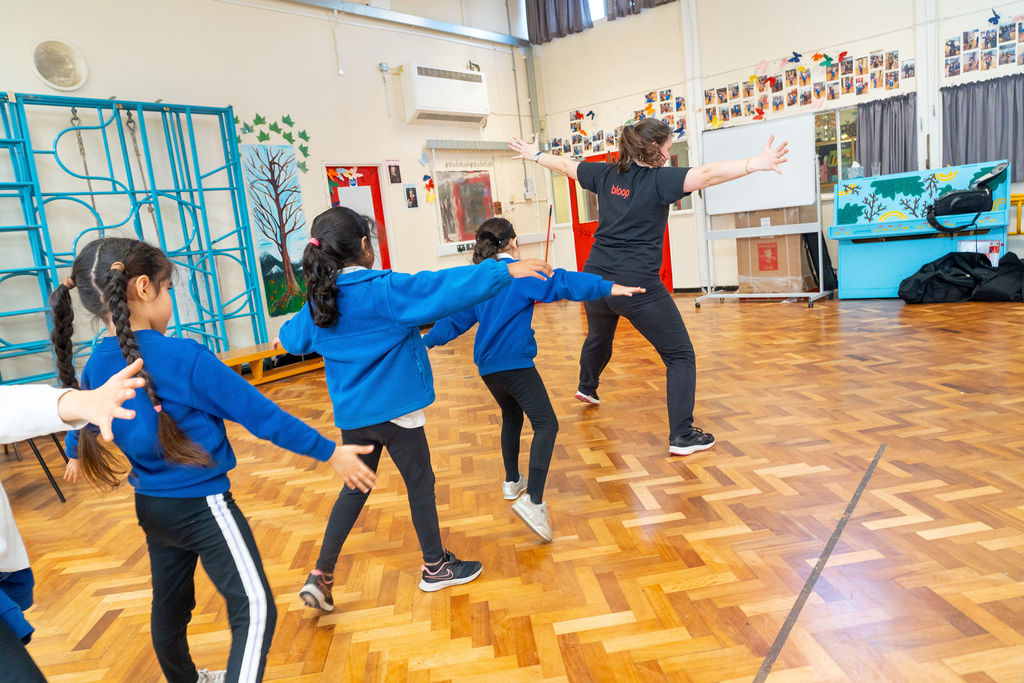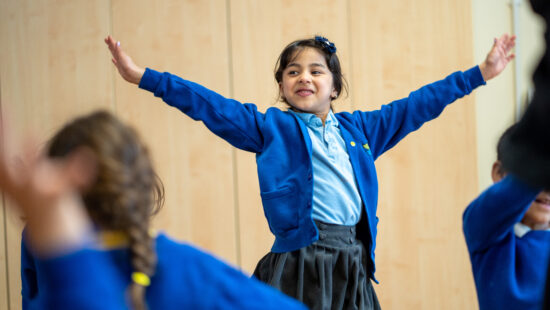Using performing arts to improve behaviour in schools

Using performing arts to improve behaviour in schools
Most teachers agree that the key to behaviour management is preventing the poor behaviour in the first place, rather than knowing what to do after it occurs. For that reason, there will be no advice here on how to punish a child through song, signal your displeasure using dance or give a good ‘telling-off’ in role as a drill sergeant!
Rather, this article aims to give some practical suggestions of how the performing arts can help create an environment where poor behaviour can be avoided in the first place, through keeping the children engaged and motivated throughout your lessons, and turning the tricky parts of the school day into positive experiences. What’s more, you don’t have to be a trained performer to try them.
Movement and music straight after break-time
One fairly high-risk time of day is straight after lunch time, or any break in routine in which the children may be moving from another location back into the classroom en-masse. These transitions can lead to the focus diffusing, or the children bringing their quarrels from the playground with them into the classroom, and it can sometimes take a long time to regain their engagement with the work. Try using the performing arts to sweep the children into an activity as soon as they re-enter the classroom, leaving no ‘dead-time’ in which their only task is to sit down and be quiet.
- Before the children arrive, put on a backing track with a strong pulse, and find a position where you can lead simple, rhythmic movements to the music with all the children facing you.
- When the children enter they must take their place and copy your movements.
- As this activity becomes routine you can vary the music you use, suggesting different qualities of movement through music of varying tempo, time-signature and genre.
- Try letting children lead the activity, perhaps even setting this up before lunch-time, so one or two children know they have a job to do as soon as they come back to class.
As well as engaging the children immediately, this type of whole-class activity changes the children’s physical and mental state, bringing the group together in a positive, expressive activity, which can wash away any niggling problems that may have occurred immediately before your lesson.
Rhythmic refocus during lessons
As we know, it’s not only on the way into class that attention can wander, and maintaining focus during lessons is a key-factor of behaviour management. Using call and response clapping rhythms is a good way of bringing the class back together, listening and focussing for a new instruction or activity, and here are some tips for executing this as effectively as possible.
- Keep the rhythms varied, and enjoyable. If you always clap the same rhythm for the children, they will quickly get used to it and it will cease to hold their interest.
- Vary sounds you use; throw in clicks, stamps and knee-slaps to keep the children guessing.
- Extend the activity; use a drum, and ask the children to answer a hit on the skin of the drum with a clap, and a hit on the rim with a click; perhaps different instruments require a different response (e.g. click your response to the tambourine, stamp to the wood-block etc.)
- Perhaps certain rhythms aren’t simply copied, but are answered by a different rhythm.
Drama games to vary the configuration
There are often certain children that you would rather didn’t sit together, and certain groupings can lead to poor behaviour, sapping a lot of the focus out of your lesson. Obviously, you can separate children, or have a seating plan, but there may be times when you want to mix up groups without drawing attention to the fact that you are doing so. The drama game Fruit Salad is a good way of varying the groupings invisibly.
- Divide the children into four groups (traditionally four types of fruit).
- Whenever they hear their group called out, the children swap seats.
- Have one seat fewer than you have children. Whoever is left without a chair calls out the next group.
- You can increase the challenge in this by using characters instead of fruit (e.g. magician, soldier, thief, king/queen), and asking the children to move in character, perhaps even interacting as they pass one another.
- The characters you choose could link to the book you are reading, or the topic being studied.
- Try naming the groups as movement instructions (e.g. smooth, spiky, heavy, light), using a backing track to inform the movement as the children swap chairs.
However you choose to play this versatile game, when you’re done the children will all be in different places, and you can begin the lesson having hidden your classroom shake-up in an enjoyable performing arts activity.
‘Performing’ rewards systems
All these suggestions manage behaviour through focusing on the positive, and you will doubtless have used various reward systems as an incentive to good behaviour in the classroom. Using drama, you can take these reward systems even further, and turn them into activities in themselves.
- Set your rewards up as an award ceremony, that takes place in the final five minutes of your lesson.
- Go into role as the host of a glitzy ceremony, and invite those that have been rewarded to come up and give an ‘acceptance speech’. You could even have a shiny envelope from which you reveal the winners!
- As part of their speech, you could ask the children to speak about why they have been rewarded, and even how they intend to keep up that good work or behaviour, and keep improving.
- Encourage the usual tears, gushing emotions and ‘I’d like to thank….’ elements to make this fun and performative.
- You could let a child be the host, once the children are familiar with the format.
These ideas could turn your rewards system into a part of the day the children really look forward to, with the positive impact on behaviour growing as they are ever more keen to impress and take part in the ‘ceremony’.
The performing arts are deeply infused with the skills and values that promote a positive atmosphere, and therefore good behaviour. A classroom full of collaboration, listening and responding, sharing ideas and positive expression will be a happy classroom in which poor behaviour is less likely to occur in the first place, and the children are more likely to actively look forward to each new day.
Eventually the children will be able to lead these re-focus activities, and they could even build into a simple rhythmic performance-piece, in the style of Stomp! The key is that these activities are not punitive measures, but enjoyable performing arts activities with lots of learning opportunities embedded within them. The children will focus, and behave better if you are relishing leading these call-and response games, and valuing them as opportunities in themselves.



